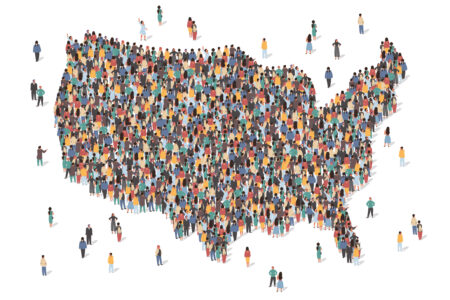
Share On Social!
The Latino population increased to 63,664,346 in 2022, representing 19.1% of the total U.S. population, according to new Census data.
Here is everything you need to know about the growing number of Latinos.
Latinos by The Numbers
The number of Latinos in the U.S. grew by 1,017,302, a 1.7% increase, from 2021 to 2022.
California (15,732,180), Texas (12,068,549), and Florida (6,025,030) continue as the US states with the largest Latino populations.
New York (3,867,076) was the only state to experience a drop (-0.7%, -27,522) in the Latino population.
South Dakota had the fastest-growing Latino population (2,835 residents), with an increase of 6.8%.
By county, Los Angeles County had the largest Latino population (4,766,616), followed by Harris County, Texas (2,131,839) and Miami-Dade County, Florida (1,848,083).
Latino Population Growth in Texas
In addition to national growth, Latinos continue rising in Texas.
Harris County, including Houston, had the largest-gaining Latino population in the US, up by 34,782, or 1.7%, in 2022.
Kaufman County, Texas, where the Latino population increased by 14.1% (5,741 people), had the fastest growth among US counties with a Latino population above 10,000.
In the state of Texas itself, Latinos have become the largest share of the state’s population (40.2%) for the first time.
“The new figures showing Latinos outnumbering white Texans by about 129,000 cap off a population boom that has been recasting the state for several decades,” The Texas Tribune reported.
Defining “Hispanic Origin” on the Census
Individuals filling out the Census can choose between two [backgrounds], “Hispanic or Latino” or “Not Hispanic or Latino.”

What defines being “Hispanic or Latino” when filling out the Census?
According to the Census website, the U.S. Office of Management and Budget (OMB) defines “Hispanic or Latino” as a person of Cuban, Mexican, Puerto Rican, South or Central American, or other Spanish [heritage] or origin regardless of [background].
The Census Bureau has conducted content tests to improve the design and function of different questions on background since the 1970s.
With the growth in variety of the population, individuals may find the categories confusing or wish to see their specific on the census questionnaire.
Census research showed that, over time, an increasing number of people do not identify with any of the official OMB categories, contributing to a rise in respondents who are classified as (SOR).
The Census website reports, “This was primarily due to reporting by Hispanics, who make up the overwhelming majority of those classified as SOR, not identifying with any of the OMB categories.”
Today, the Census Bureau’s code list contains over 30 Hispanic or Latino subgroups. The Census Bureau has continued to conduct research and outreach regarding background.
Read more about the usage of the terms Latino and Hispanic.
The Importance of Latino Health
With the Latino population continuing to grow rapidly, the health of Latinos is also important.
Latinos often face a multitude of health inequities that contribute to health differences in cancer, Alzheimer’s, and other health conditions.
Inequities that the population faces include:
- Health mistreatment and
- Wage gaps and workforce mistreatment.
- Housing, transportation, and green spaces.
- Access to healthcare and clinical trials.
The need for wide spread change to eliminate differences that are impacting Latinos is crucial.
Advocate for Latino Health in Your Community!
You can speak up for Latino health where you live.
Enter your county’s name to receive health-related data through the Salud America! Health Report Card.
The report card serves as a data dashboard tool that auto-generates Latino-focused and local data with interactive maps and comparative gauges.
This can help you visualize and explore health-related factors in your area compared to your county to the rest of the state and the nation.
The data from the report card can help start or support a conversation about solutions to differences that impact your community! Share it with local leaders and on social media!
Explore More:
Increasing Civic EngagementBy The Numbers
50
percent
of big U.S cities have a local board of health



